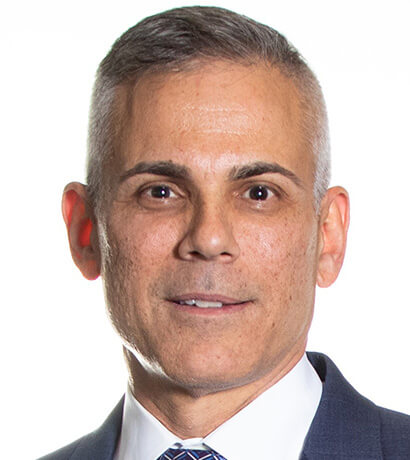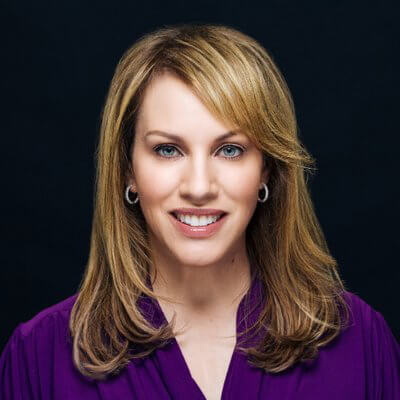- May 06, 2020
- By Liam Farrell
The project had all the makings of a blockbuster: unaired, behind-the-scenes footage of one of pro basketball’s greatest dynasties; candid new interviews with one of the most transcendent athletes in history; and, with live competition on indefinite hold due to the novel coronavirus pandemic, a public starved for new sports content.
And two Terps helped bring it to life.
“The Last Dance,” a 10-part documentary series airing Sunday evenings through May 17 on ESPN, has been a bona fide smash. Centered around the 1997-98 NBA season and the sixth championship of the Chicago Bulls and superstar Michael Jordan, the series has become the network’s most-watched documentary, dominated sports talk shows and generated an unending supply of social media memes.
Both Curtis Polk ’81 and Estee Portnoy MBA ’96 are listed as executive producers, but their influence on Michael Jordan’s world is much more far-reaching. For decades, the pair has been part of Jordan’s close-knit inner circle, advising him on business and investment decisions, and coordinating media relations and statements to the press.
“If you are going to tell the story, why not tell it from the people who knew it?” Portnoy said. “We were able to let him speak for himself.”
 Taking Flight
Taking Flight
Polk was the first of the Terps to take flight with Air Jordan. He was working in Washington, D.C., as an accountant, when a friend told him about a job at sports management firm ProServ, and in 1989 he took over its financial advising and tax planning division.
He met Jordan shortly thereafter—the athlete’s exploding fame unnerved him less than his wanting to help one ProServ’s most important clients.
“We hit it off. We complement each other,” Polk said. “I look at things a little on the downside. He’s the ultimate optimist.”
The relationship has held steady since. Polk co-founded a new agency with Jordan’s longtime agent, David Falk, in 1992, and has worked exclusively with Jordan since 2001, now as vice chairman of sports and entertainment for the Charlotte Hornets, where Jordan is the majority owner.
His general philosophy in business and media, Polk said, has been making sure Jordan is “not overexposed.”
“Less is more,” he said. “You want to stretch out his popularity and fame.”
 Portnoy was someone Polk thought would help in that. The two had met through Kids Enjoy Exercise Now (KEEN), the charity begun by Portnoy and her husband, Elliott. Portnoy was working in marketing for a software company when Polk floated a business manager job to her over a 1996 dinner. Unsure whether to take the leap—and uneasy about knowing almost nothing about the NBA—she was won over after meeting Jordan, who didn’t even ask her a single basketball question.
Portnoy was someone Polk thought would help in that. The two had met through Kids Enjoy Exercise Now (KEEN), the charity begun by Portnoy and her husband, Elliott. Portnoy was working in marketing for a software company when Polk floated a business manager job to her over a 1996 dinner. Unsure whether to take the leap—and uneasy about knowing almost nothing about the NBA—she was won over after meeting Jordan, who didn’t even ask her a single basketball question.
“Not being a fan is probably the most helpful part,” Portnoy said. “I don’t usually back down and neither does he. He doesn’t need to be surrounded by a lot of ‘yes’ people.”
It took about two years for Portnoy to learn to manage the flow of an NBA season and identify what sort of media and endorsement requests she could decline without faxing a list over to Jordan. The demands on his time were astronomical, she said, and Jordan would remind her, “I don’t pay you to be liked by anyone but me.”
“I had to learn to toughen up,” she said.
A New Opportunity
The origins of the new documentary have been almost mythical in basketball circles for decades. A producer for NBA Entertainment dreamed up an all-access pass to the 1997-98 Bulls, and after capturing more than 500 hours of film, waited for Jordan to sign off on its use.
There were lots of proposals over the years, but none got off the ground. One of the biggest hurdles, Polk said, was that a standard-length documentary wouldn’t give enough context to Jordan’s legendary competitiveness or the fraying relationship between the players and Bulls management.
“You couldn’t do it in 80 or 90 minutes,” he said. “It’s not really going to give people the real story.”
That changed by 2016, when Netflix’s “Making of a Murderer” and then ESPN’s “O.J.: Made in America” succeeded as episodic documentaries both critically and in ratings. Polk and Portnoy had been vetting companies for a more expansive approach, and producer Mike Tollin’s initial proposal of six to eight episodes eventually stretched into 10 segments bouncing between the unaired footage, present-day interviews and detours on subjects such as the childhoods of Jordan and his teammates, the rivalry with the Detroit Pistons and the Olympic “Dream Team.”
Polk said the goal was to give basketball fans who never got a chance to see Jordan play a window into the unprecedented challenges facing that Bulls team, from the on-court elbows of a much more physical league to contract standoffs with the front office and the unrelenting media microscope of “a (cultural) craze before there was social media.”
“They were under such adversity,” Polk said of the Bulls. “They were able to get through all that and function. Most sports teams could never (do that).”
Portnoy said the attention to the documentary has reminded her of one of her first jobs with Jordan, handling publicity around the basketball-Looney Tunes crossover film “Space Jam.” She hopes that viewers begin to understand the effort Jordan expended every day to reach his stratospheric success.
“Nothing was ever given to Michael,” she said. “He would intensely outwork everyone.”
Topics
PeopleTags
Basketball